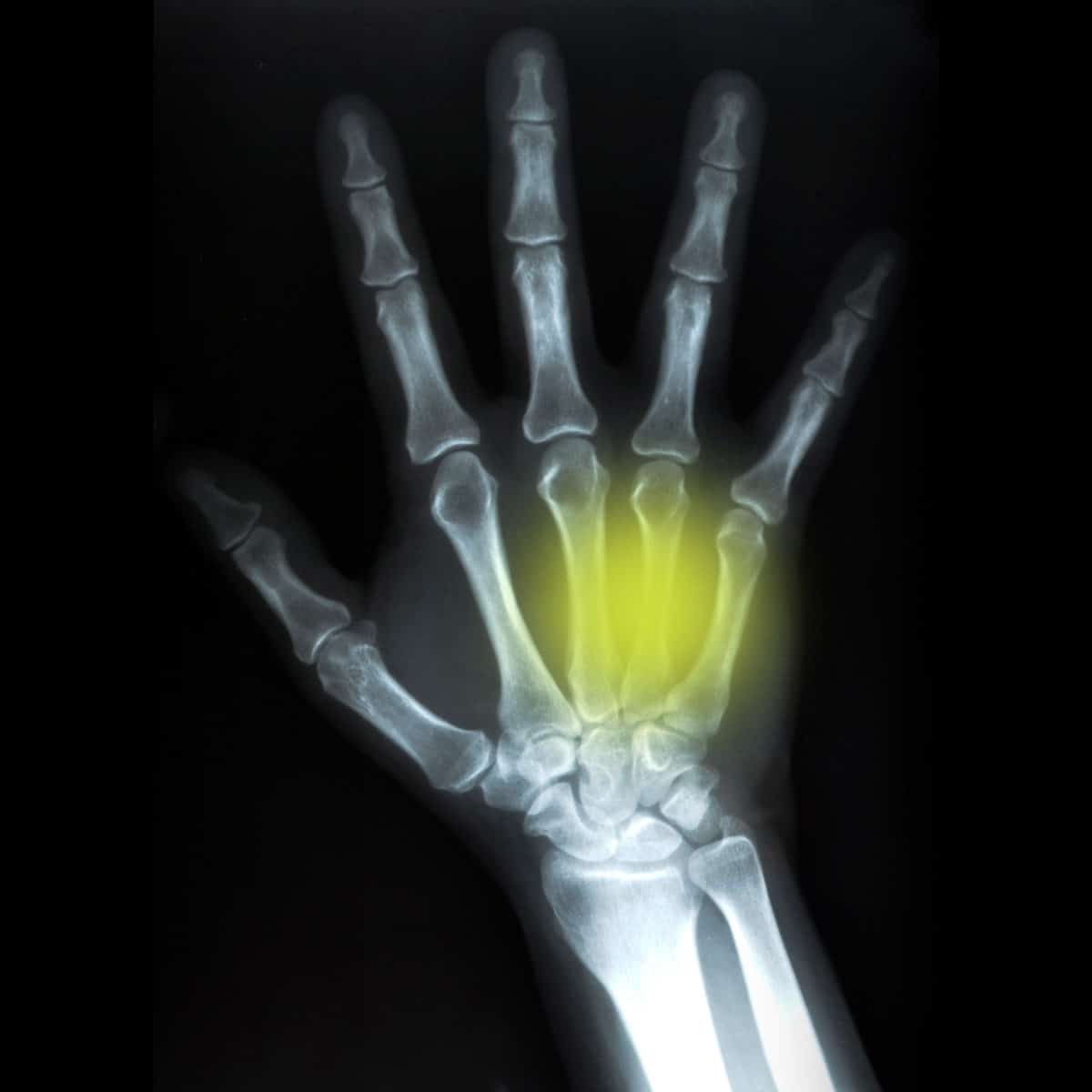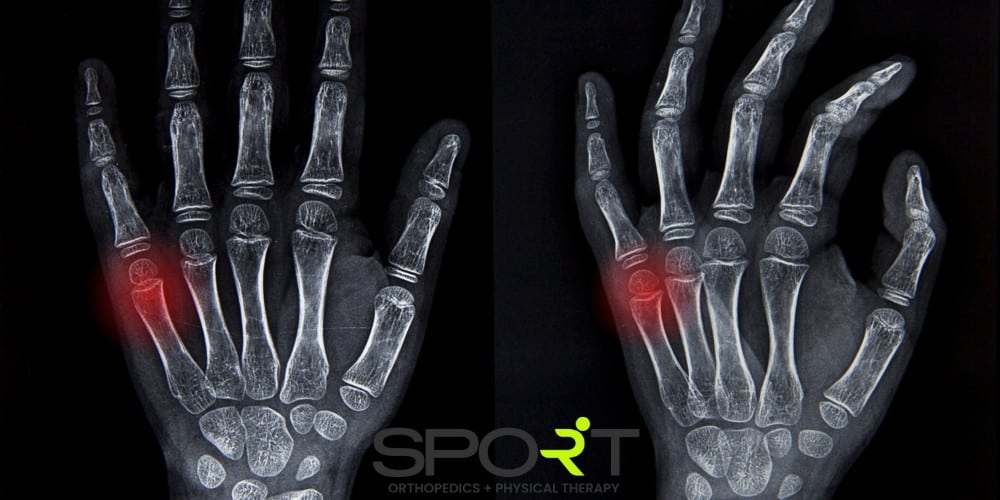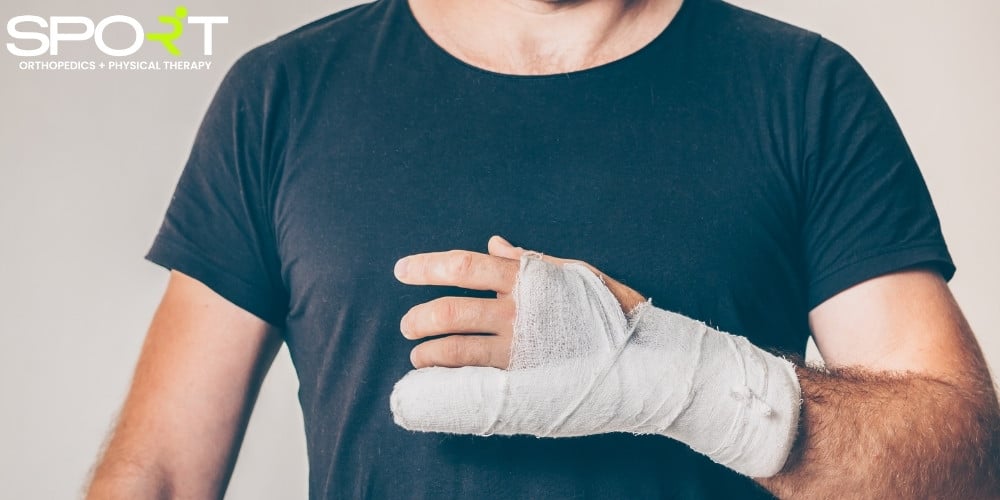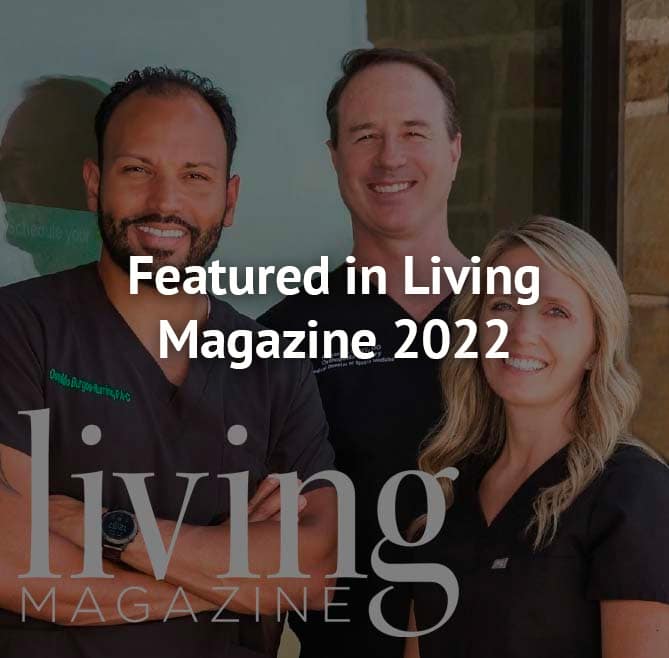Boxer Fracture Treatment in Dallas, Frisco, Prosper, and Wylie, TX
5th Metacarpal Fracture, Boxers Knuckle, Boxers Break Specialists, Boxers Fracture Surgery
A boxer’s fracture, also called a boxer’s break or a fifth metacarpal fracture, occurs when the bone at the knuckle of the little finger breaks. This can be the result of a forceful injury during a fight or hitting a solid object. A boxer’s fracture will cause swelling, pain, stiffness, or a bump on the finger, and boxer fracture treatment involves realigning the broken bone and providing stabilization while the bone heals.
The orthopedic specialists at SPORT Orthopedics + Physical Therapy treat all sorts of sports-related ailments, from sprained toes to upper arm pain. Some acute injuries, like fractures, can be incredibly painful and often need more treatment than you can get at home. The RICE method works wonders for small aches and muscle pains, but bone injuries need proper medical treatment to heal correctly. For more information about how our specialists can help, call us at (469) 200-2832. We even offer same-day and Saturday appointments!
What’s more, is that we now offer Dallas, Wylie, Prosper, and Frisco orthopedic urgent care. Rather than paying an arm and a leg at the ER or waiting for hours at the regular urgent care clinic, SPORT can see you sooner at a much lower cost. Our state-of-the-art ortho urgent care facilities are equipped with both diagnostic and imaging equipment, and we even offer on-site physical therapy. In other words, when you suffer a sudden orthopedic injury, SPORT has you covered.
Hand Anatomy
More than half of your bones are in your hands and feet. Your feet may provide a stable foundation, but our hands are tools that allow us to interact with and manipulate the world around us. It’s no coincidence that we have 10 digits, and we use a 10-base counting system.
Each hand has 27 bones, 27 joints, 34 muscles, and over 100 ligaments and tendons. 8 carpal bones make up the wrist, and your palm is made of five metacarpal bones. 14 bones make up the digits (fingers), and these are called phalanges.
Each finger has 3 phalanges, and the thumb has 2. With so many different parts, it’s important for your provider to know which part of the hand is injured and develop a safe treatment plan.

What Is a Boxer’s Fracture?
A boxer’s fracture is a type of metacarpal fracture (remember, the metacarpal bones are in your palm!). Metacarpal fractures are relatively common, making up 40% of all hand fractures. A metacarpal neck fracture in the fifth metacarpal is commonly known as a boxer’s fracture. It gets its name from the way the injury happens.
Most of these fractures happen when a closed fist comes into contact with an immovable object, such as a wall, or someone’s jaw or head during a fist fight. This force fractures part of the metacarpal bone. The blunt impact can cause the bone to break into several different patterns and pieces.
What Does a Boxer’s Fracture Look Like?
The average person may not be able to diagnose a boxer’s fracture on sight alone. The hand will swell and may bruise. The normal shape and contour of the knuckle may deform or seem to disappear. This occurs because the fracture bends the bone, and the metacarpal head is no longer prominent. A Dallas orthopedic doctor can determine the extent of your injury and come up with the best treatment plan.

What Does a Boxer’s Fracture Feel Like?
A boxer’s fracture can cause the area around your little finger and knuckle to feel painful, and the pain will increase with any kind of movement. In some cases, people will experience only mild pain. In other cases, it may be impossible to move the affected finger without severe pain. The little finger may overlap the ring finger when you make a clenched fist because of malrotation. If you have severe pain when moving your hand after an injury, it’s important to see a doctor right away.
Where Does a Boxer’s Fracture Occur?
A boxer’s fracture is when the fifth metacarpal bone breaks. This is the bone in your palm right below your pinky finger. The metacarpal bone connects to your phalanges or finger bones. Metacarpals are the most commonly broken bones in the hand. Metacarpal fractures can happen in four different areas: the head, neck, shaft, or base of the metacarpal.
The head of the metacarpal bone makes up part of your knuckle and gives it its normal bumpy shape. Metacarpal neck fractures are the most common since the bone is the thinnest at the neck.
How Is a Boxer’s Fracture Diagnosed?
A doctor can diagnose a boxer’s fracture by a combination of a physical exam and X-rays. The X-rays can show the type of fracture and dislocation. In rare cases, a CT scan may be used to provide a more detailed image.
What Are the Symptoms of a Boxer’s Fracture?
Symptoms of a boxer’s fracture can include:
- Pain around the pinky knuckle
- Swelling and/or painful bruising at the fracture site
- Immobility of the 4th and 5th fingers
When to See a Doctor
If you believe you have a boxer’s fracture, you should see an orthopedic specialist. Going without treatment can cause many unwanted complications. An untreated boxer’s fracture can affect your hand grip strength and result in a limited range of motion. It can also lead to you having a claw-like pinky finger that is unable to straighten out. If you experience severe pain after punching solid objects, seek medical care.
Boxer’s Fracture Treatment
So, how is a boxer’s fracture treated? Many boxer’s fractures can be treated by immobilizing the joint to promote healing. This immobilization can be achieved with a variety of splints, a cast, or taping techniques, depending on the severity of the break itself.
“Buddy-taping” involves taping the little finger to the ring finger and is a popular option for a lot of athletes. Buddy taping can help stabilize the joint and prevent some pain. This method is used when you can’t get to a doctor immediately.
Boxer Fracture Splint
As long as the injured bone does not have any serious or displaced fractures, it could be treated with a simple splint. To treat a boxer’s fracture with a splint, your doctor will first ensure proper alignment of the fractured bones. They do this by gently manipulating them back into their normal position.
The splint will extend from the wrist to beyond the knuckles, with the fingers positioned in a slightly bent position. The splint will be snug but not too tight, allowing for any potential swelling. It’s important to seek attention from a skilled orthopedic specialist for proper diagnosis and treatment.
Broken Hand Recovery Time
During the initial weeks, a cast or splint is typically used to immobilize the hand and promote proper healing. After the immobilization period, rehabilitation exercises and physical therapy may be recommended to restore strength, flexibility, and functionality to the hand.
Generally, simple fractures may take about 6 to 8 weeks to heal, while more severe fractures or those requiring surgical intervention might take longer.
How Long Does a Boxer’s Fracture Take to Heal?
Physical therapy with a hand therapist is usually recommended following immobilization and/or surgery. This typically takes four to six weeks for a hand fracture to heal and many additional weeks for it to regain motion and strength.
During this time, you should avoid heavy lifting, gripping, and contact sports for about three months or for the amount of time your doctor suggests. People that have surgery generally require longer recovery periods than people that do not have surgery. Letting the fracture heal is the most important aspect of recovery. You don’t want to do anything that would set back your healing process.
Boxer Fracture Surgery
In most cases, broken bones are treated by setting the bone and using a cast or splint for stabilization while the bone heals. For an unusually severe boxer’s fracture, your doctor may recommend fracture surgery, which could involve a closed reduction. Surgery is recommended for boxer’s fractures if large degrees of angulation or displacement occur.
It is also recommended if the joint surface is misaligned. Displacement and angulation mean that a piece or pieces of the broken metacarpal bone have moved out of position. A bone fragment out of place can slow down the healing process and may even cause the bone to heal incorrectly.
An open reduction and internal fixation, or ORIF, surgery allows surgical hardware, such as wires and screws, to be placed in the bone to align the fracture and allow it to heal in the correct position. It is important to see your doctor immediately after any injury, especially when you have reason to believe you may have broken a bone.

Is a Boxer’s Break Preventable?
Because the majority of boxer’s fractures are to some extent self-inflicted, you can avoid boxer’s fractures by avoiding the situations that cause them. You should avoid bare fist fighting. Gloves can protect your hands while boxing for sport.
Home Care for Boxer’s Fracture
Some steps can be taken to reduce pain and swelling at home while you wait on your appointment with a doctor. The RICE method is a classic and effective treatment option. Rest, ice, compression, and elevation can go a long way in reducing swelling and relieving pain.
Over-the-counter pain medicine like acetaminophen can also help reduce inflammation and relieve pain. A broken bone should always get treatment from a qualified health provider. Home care should only be used while waiting on an appointment or after you see a doctor.
Call SPORT Orthopedics + Physical Therapy for Boxer Fracture Treatment in Dallas

A boxer’s fracture can be an incredibly painful injury that can have lasting complications if left untreated. At SPORT Orthopedics + Physical Therapy, our dedicated providers are ready to get your life back. We know how even seemingly minor injuries can cause undue stress and pain. Let us help! Call us today at (469) 200-2832 to schedule an appointment at one of our three locations. You can also request an appointment online.
We look forward to treating you!


